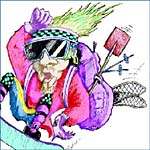MOUNTAIN DEW AND ESPN2 avidly promote the image of snowboarding in the half-pipe, where acrobatic skateboard-influenced aerials are the rule. Certainly that’s where the advertising dollars are found, as corporate marketers eagerly target the deep, baggy pockets of Generation Y. But here in the Northwest, the true essence of the sport is far from the half-pipes and terrain parks recently added to local ski areas. Off the groomed runs, beneath the ropes, past the “out of bounds” signs—when the ski patrol isn’t looking—young riders are flooding into the backcountry. That’s the powdery mecca of local boarding, yet as one might expect of a sport that’s predominantly young and male, it’s also highly dangerous terrain.
“Young people tend to take more risks,” says Dr. Christopher Van Tilburg, the author of Backcountry Snowboarding (Mountaineers Books, 1998). “You don’t have much experience at that age,” he notes, especially given the sport’s short, steep learning curve—which can lead young riders into the mountains after only a few weeks on their boards.
Last winter four boarders were killed in the Northwest: two in avalanches near the Mount Baker Ski Area; another plunged off an Alpental cliff; the fourth hit a tree at Crystal. Statewide, many more suffered various injuries. Backcountry skiers, too, succumbed to last winter’s epic snowfall, as did snowshoers, snowmobilers, and anyone else who underestimated the dangers of weather, terrain, and avalanche.
But it’s the new, young riders who are headed into the backcountry at the fastest rate, unsurprising given that snowboarding is the hottest segment of the winter sports economy. “It’s getting huge,” declares Van Tilburg of riders’ interest in the untracked, unpatrolled regions beyond ski areas’ demarcated boundaries (where their liability ends). The Summit at Snoqualmie’s Joanne Nelson says their ski patrol attempts to educate riders on out-of-bounds hazards and to “remind them to go with groups or with partners.” Yet she points to peer pressure and riders’ “I-can-do-that” attitude as factors that still lead them into trouble.
Avalanches mean big trouble, of course, especially in the Northwest, where soggy fallen snow sets like concrete. If you aren’t killed by the initial trauma, you’ll generally asphyxiate in 30 minutes. According to Ken White, now retired from the Northwest Weather and Avalanche Center (NWAC), “Your chances of survival are near zero if you have to depend on somebody else to get you out.” That’s why the standard alpine tools of self-rescue—shovels, avalanche beacons, and snow probes—are now considered essential for backcountry travel.
GEAR CAN HELP, but only to a point. It can lead to a false sense of security, says Van Tilburg. “People buy the stuff, go up, and think they’re going to be safe,” he explains, yet if riders don’t know how to use it, “it’s just deadweight in your backpack.” Moreover, the gear ain’t cheap. An avalanche beacon used to home in on the reciprocal signal of a buried buddy costs around $250, which many riders would rather spend on a new board—or beer.
Education is the main emphasis of the NWAC’s invaluable Web site (www.noaa.gov)and telephone hotline (526-6672). The site contains links to White’s own educational outreach programs and a host of other resources (including the excellent www.avalanche.org site), among them clinics and seminars at The North Face, Marmot, REI, Seattle Mountaineers, and Mountain Madness (some free, some not).
But boarders can be maddeningly hard to reach. “The snowboarder is kind of unaffiliated,” says White. According to Van Tilburg, “It’s kind of a slow road” to educate independent-minded riders. And doesn’t the very notion of an avalanche safety course conjure up a stodgy classroom image? “Exactly,” he says. (After all, who wants some old dude lecturing you in front of a blackboard?) Yet both Van Tilburg and White cite increased efforts by boarding “ski” patrollers and avalanche instructors to tailor their message to the pierced navel set. Van Tilburg also believes that the historical antipathy between younger riders and older ski patrollers is gradually dissipating.
ON THE STREET, as it were, ever more young riders are preparing for the coming backcountry snows. Yet according to Tom Pogue, president of the hip Faction shop and himself an avid out-of-bounds rider, avalanche awareness is growing among his young customers. “Now it’s become cool to know that stuff,” he says, explaining that boarders are willing to hear about safety on a “peer-to-peer basis.” His sales of backcountry gear—including books!–have “grown immensely,” he adds, as manufacturers like Burton sell a safety-is-cool image with their products. Pogue adds that the backcountry deaths of celebrity riders has also sobered up young ‘tudes.
But avalanches aren’t the only danger in the mountains. The chances of tumbling off a cliff or down a couloir have made helmets more popular with the backcountry crowd. And riders get lost with surprising frequency, even within earshot of the highway; a daypack containing the proverbial “ten essentials” includes extra food and clothing, a map and compass, a headlamp, and a cell phone—scoffed at by traditionalists, but a proven lifesaver. Nationwide, dozens of lost boarders were stranded overnight—or nights—last winter, and hypothermia can kill just as surely as an avalanche. For backcountry riders, the coming ’99 Y2K season will be as extreme—and as extremely hazardous.
Gear
- Black Diamond Ascension shovel,
$50 at Gregg’s Greenlake Cycle
- K2 convertible trekking poles/avalanche probes,
$100 at Snowboard Connection, downtown Seattle
- K2 Clicker Traverse snowshoes with step-in bindings,
$220 at Boarderline in Bellevue
- North Face Dare Pack,
$125 at downtown Seattle North Face
Other items to pack
- *G3 Collapsible Avalanche Probe,
$63 at Marmot in Bellevue
- *Red Tramp-Ons, for extra boot traction,
$72 at Faction, downtown Seattle
- *Ortovox F-1 Avalanche Beacon Transceiver,
$250 at downtown Seattle REI
- *The Avalanche Handbook, $19.95
- *The ABC of Avalanche Safety, $6.95
- *Avalanche Safety for Skiers and Climbers, $16.95
- *100 Classic Backcountry Ski and Snowboard Summits in Washington,
$17.95; (all from The Mountaineers Books)








